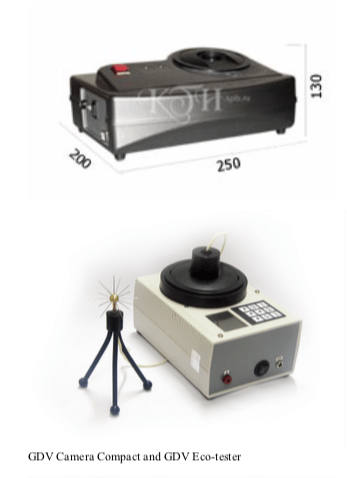ELECTROPHOTONIC IMAGING (GDV) TECHNIQUE
Konstantin Korotkov, PhD, Professor
Electro-diagnostic techniques such as Electro-encephalogram and Electro-cardiogram are widely used in medical practices worldwide. A promising method already utilized in sixty-two countries to great success is bioelectrography, based on the Kirlian effect. This effect occurs when an object is placed on a glass plate and stimulated with current; a visible glow occurs, the gas discharge. With EPI/GDV (electro-photon imaging through gaseous discharge visualization) bioelectrography cameras, the Kirlian effect is quantifiable and reproducible for scientific research purposes. Images captured (EPI-grams) of all ten fingers on each human subject provide detailed information on the person’s psycho-somatic and physiological state1. The EPI/GDV camera systems and their accompanying software are currently the most effective and reliable instruments in the field of bioelectrography2,3,4,5. EPI/GDV applications in other areas are being developed as well6,7,8,9,10,11.
Through investigating the fluorescent fingertip images, which dynamically change with emotional and health states, one can identify areas of congestion or health in the whole system. The parameters of the image generated from photographing the finger surface under electrical stimulation creates a neurovascular reaction of the skin, influenced by the nervous-humoral status of all organs and systems. Due to this, the images captured on the EPI/GDV register an ever-changing range of states. In addition, most healthy people’s EPI/GDV readings vary only 8- 10% over many years of measurements, indicating a high level of precision in this technique. A specialized software complex registers these readings into parameters which elucidate the person’s state of wellbeing at that time12.
The EPC/GDV camera is presently the state-of-the-art in bioelectrography. It utilizes a high frequency (1024 Hz), high-voltage (10 kV) input to the finger (or other object to be measured), which is placed on the electrified glass lens of the EPC camera. Because the electrical current applied to the body is very low, most human subjects do not experience any sensation when exposing their fingertip to the camera. In practice, the applied electric field is pulsed on and off every 10 microseconds, and the fingertip is exposed for only 0.5 seconds. This causes a corona discharge of light-emitting plasma to stream outward from the fingertip. The light emitted from the finger is detected directly by a CCD (charge-coupled detector), which is the state-of-the-art in scientific instruments such as telescopes to measure extremely low-level light. The signal from the CCD is sent directly to a computer, and software analysis is done to calculate a variety of parameters that characterize the pattern of light emitted, including brightness, total area, fractality, and density. The software can also provide color enhancement to enable subtle features such as intensity variations of the image to be perceived. The underlying principle of camera operation is similar to the well-known Kirlian effect13 but modern technology allows reproducible stable data with quantitative computer analysis. Purposeful investigations allowed the discovery of the parameters that are optimal from the point of obtaining critical information on the biological object’s state with the minimum of invasiveness. These findings are described in more than 200 research works in the international scientific literature, 15 patents, 9 books in English, French, German, Italian, Russian, and Spanish.
This biophysical concept of the principles of GDV measurements is based on the ideas of quantum biophysics714. This is a further development of well-known ideas of A. Szent-Györgyi concerning the transfer of electron-excited states along the chains of molecular protein complexes815. The EPC technique measures the level of functional energy stored by the particular systems of an organism. This level is defined by the power of the electron-excited states and the character of their transport along the chains of albumin molecules. The level of functional energy is correlated with health status, but it is only one of many of the components that define health. It works together with genetic predisposition, psycho-emotional states, environmental loading (food, water, air, ecology) and other factors. This approach may be associated with the oriental notion of the energy transfer along meridians.

